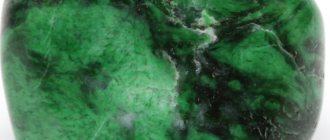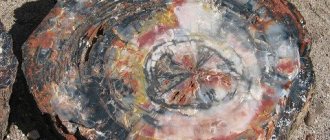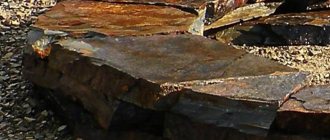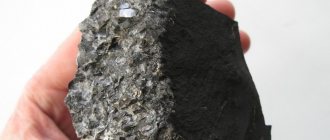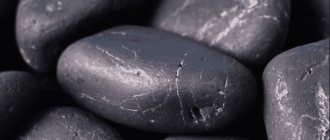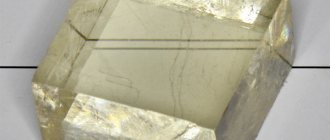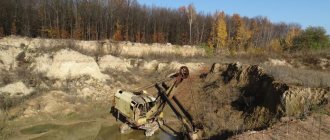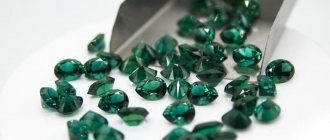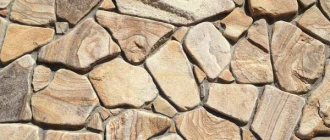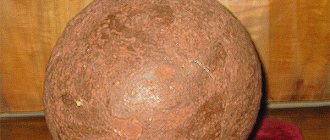Magic stone shungite: YouTube/Vanessa Hernandez Shungite stone is known for its mystical properties, and its origin is still hotly debated. Peter I opened the first balneological resort Marcial Waters in places where there were deposits of healing stones. For some zodiac signs, astrologers recommend wearing it on their hands as an amulet. Let us reveal the secrets of the impact of shungite on humans.
History of shungite
Shungite is a rock that was once based on organic deposits that were transformed into carbon during a long stay at great depths underground.
The structure of the stone is similar to graphite. Advertising - Continued below
The rock was first described several centuries ago: first in 1792 by academician N. Ya. Ozeretskovsky, and then in 1848 by mining engineer N. K. Komarov. Shungite was discovered in the Transonezh village of Shunga, in whose honor it received its name. Gave the name to the mineral A. A. Inostrantsev
In 1928, a state trust called “Shungite” was created and until 1937 the study of this rock was carried out. It was initially assumed that it had similar properties to coal.
Travel around Karelia
Healing properties of shungites Chemical composition of shungites Scope of application of shungites Application of shungite in medicine Shungite and water Healing shungite pyramids Treatment of allergies with shungite Treatment of childhood anemia with shungite Treatment of asthma with shungite Treatment of gastritis with shungite Treatment of diabetes mellitus with shungite Gallstone disease Treatment of angina with shungite Treatment of enteritis with shungite
COMPOSITION OF SHUNGITE
According to scientists, the age of shungite is almost 2 billion years. Outwardly, this rock is similar to coal, but it lies in very ancient layers of the earth's crust, formed during a period when there was nothing living on Earth. Where did this strange stone come from? After all, at that time there were no forests growing on our planet from which carbon compounds, that is, coal and stones, could be formed. Experts believe that only protobacteria could develop in an oxygen-free atmosphere. There are several theories explaining the origin of shungite. Firstly, there is an assumption that primitive microscopic organisms lived in the shallow bays of the ancient sea. Marine sediments, saturated with their organic remains, served as the main material from which shungite was formed. The second, rather exotic version, says that shungite is part of a meteorite that brought to Earth a piece of the disintegrated planet Phaeton, on which an oxygen form of life once existed. The giant fragment of Phaeton formed a shungite deposit at the site of its fall. Some researchers argue that the shape and structure of shungite bodies have the characteristics and characteristics of volcanic substances. Perhaps the volcanic release of shungite substance into the atmosphere played the same role as the hypothetical fragment of the planet Phaeton. A similar point of view was reflected even in the Great Soviet Encyclopedia. In it, only a few lines are dedicated to shungite, and I want to quote them in full: “Shungites (from the name of the village of Shunga of the Karelian Autonomous Soviet Socialist Republic), Precambrian rocks saturated with carbon (shungite) substance in a non-crystalline state. During metamorphosis they turn into graphitoids - cryptocrystalline graphites. Unstratified (migration) rocks contain up to 99% carbon and are found in the form of sheet and secant veins, nests, and tonsils. The color is black with a strong semi-metallic sheen, the fracture is conchoidal; hardness on the mineralogical scale is 3-3.5, density 1840-1980 kg/m3. The ash contains V, Ni, Mo, Cu, Ce, As, W, etc. Stratified shungites form layers of varying thickness in the volcanic-sedimentary strata of the Middle Proterozoic. They differ in the composition of the mineral base (aluminosilicate, siliceous, carbonate) and the amount of shungite substance. Shungite rocks with a silicate mineral base are divided into low-carbon shungite-containing (up to 5% C), medium-carbon shungite (5-25% C) and high-carbon shungite (25-80% C). Shungite is a valuable raw material for construction and industry. Due to the ability of some shungites to swell during heat treatment, they are used as a lightweight concrete aggregate (the so-called shungizite). The high reaction properties of ash (a strong reducing agent) can be used in the production of yellow phosphorus, ferroalloys, etc. Non-stick paints are made from ash. Certain varieties of wood are used as a decorative and building material. Industrial deposits of Sh. are known in the area of Lake Onega in the Karelian Autonomous Soviet Socialist Republic.” Whichever of the proposed theories turns out to be correct, it cannot be denied that the breed discussed in the book is truly unique both in terms of structure and chemical composition, and in its healing effects. Shungite from the Zazhoginsky deposit is a unique natural formation, consisting of 30% shungite carbon and 70% silicates (80% of the mass is silica). Shungite carbon has an amorphous structure that is resistant to graphitization and is characterized by high reactivity in thermal processes, high sorption and catalytic properties, electrical conductivity and chemical resistance. The structure of shungite is unusual. The rock is a composite whose matrix is formed by carbon. Highly dispersed (less than 10 microns) silicate particles are evenly distributed in the carbon matrix. The contact surface of silicates with carbon is more than 10 m2/g.
In addition to unique fullerenes (I’ll tell you about them a little later), shungite contains elements of almost the entire periodic table. The peculiarity of this rock lies in its selective action. When interacting with a person, shungite absorbs and kills everything unnecessary, and also “adds” and restores the elements that a person needs. This phenomenon is based on the ion-exchange properties of shungite, which make it possible to selectively remove certain pollutants from the body. In addition, shungites are also able to feed us with the necessary macro- and microelements, and also selectively: from the many elements contained in minerals, the body chooses exactly what it needs. Thus, the human body gradually restores its mineral balance, which helps to cure many chronic diseases and restore energy status. Interestingly, scientists first started talking about the effects of minerals on living organisms after observing animals. In 1922, the Siberian geologist Dravert introduced into science the concept of lithophagy - eating stones. He noticed that from time to time wolves, deer and elk licked the rocks. Previously, it was believed that in this way animals find salt in nature and compensate for sodium deficiency in the diet. Then it turned out that the stones they “eat” often have nothing to do with salt. In the course of a more detailed study, the same ion exchange processes were discovered between stones and a living organism, which as a result is freed from unnecessary elements and receives the missing ones.
Chemical composition of shungite:
Properties of shungite: 1) density - 2.1-2.4 g/cm3; 2) porosity - up to 5%; 3) compressive strength - 1000-1200 kgf/cm5; 4) electrical conductivity - 1500 sim/m; 5) thermal conductivity coefficient - 5 W/m2 °K; 6) developed internal surface - up to 20 m2/g, 7) adsorption activity: for phenol - 14 mg/g, for thermolysis resins - 20 mg/g, for petroleum products - more than 40 mg/g.
Adsorption active against bacterial cells, phages, pathogenic saprophytes, etc. Shungite particles, regardless of size, have bipolar properties, which explains the high level of adhesion and the ability of shungite to mix with all substances without exception. At the end of the 20th century, scientists partially explained the reasons for the healing effect of shungite. As it turned out, the mineral consists mainly of carbon, a significant part of which is represented by spherical molecules - fullerenes. Fullerenes are a special form of carbon, first discovered in scientific laboratories while trying to simulate cosmic processes, and later discovered in the earth's crust. The discovery turned out to be important: scientists working on this topic received the Nobel Prize in 1997. To understand the nature of the miraculous effect of shungite, it is necessary to consider the properties of fullerenes in a little more detail. Until recently, it was believed that carbon has only three forms of existence - diamond, graphite and carbine (and carbine is obtained exclusively in laboratory conditions and, strictly speaking, cannot be considered a natural mineral). These substances differ in their structure. Each carbon atom in the diamond structure is located in the center of a tetrahedron, the vertices of which are the four nearest atoms. This structure determines the properties of diamond as the hardest substance known on Earth. The carbon atoms in the crystalline structure of graphite form hexagonal rings, which in turn form a strong and stable network, similar to a honeycomb. The grids are arranged one above the other in layers that are loosely connected to each other. This structure determines the specific properties of graphite: low hardness and the ability to easily delaminate into tiny flakes. But the fullerene molecule represents a spherical surface formed from hexagons and pentagons. Nature has given a clear sequence of this connection - each hexagon borders on three hexagons and three pentagons, and each pentagon borders only on hexagons. The carbon atoms forming the sphere are strongly bonded to each other. Due to their spherical structure, fullerenes turned out to be an ideal lubricant. They roll around like molecule-sized balls between rubbing surfaces. By combining different atoms and molecules inside carbon balls, you can create the most fantastic materials. Fullerenes can be used in medicine, rocket construction, military purposes, electronics, machine production, in the production of technical products, computers and others, and in all cases, the operating parameters of the equipment are significantly improved, the quality increases, the technologies become more efficient and simpler. For example, American researchers have developed a technology that makes it possible to apply the thinnest elements of solar cells to any surface - they are a multilayer polymer film containing the same fullerenes. Such cells still have approximately four times lower efficiency than traditional silicon-based batteries, but they are much simpler and cheaper to produce. Perhaps in the near future the industry will begin to produce solar panels in rolls, like wallpaper. And in one of the universities in Sweden, during experiments with fullerenes, unexpected by the scientists themselves, a puff material was obtained that resembled foil laid with thin layers of paper. The transparent and flexible material turned out to be a magnet and retained its properties even at temperatures above +200? C. It is quite possible to use it to create computer memory boards using laser writing. Thanks to this, a very high storage media density is achieved. Russian scientists at Rostov State University believe that perhaps carbon-based subminiature processors could be combined with the human body, for example, connecting them to the nervous system to learn foreign languages or keep the Great Encyclopedia Britannica in memory. Great hopes are associated with the use of fullerenes in medicine. The almost ideal spherical structure of the fullerene molecule and microscopic size (diameter 0.7 nm) allow scientists to expect that these molecules will be able to create a mechanical obstacle to the penetration of viruses into the cells of an infected organism. The idea of creating anti-cancer drugs based on water-soluble fullerene compounds with radioactive isotopes embedded inside is also being discussed. The introduction of such a drug into the tissue will allow it to selectively act on tumor-affected cells, preventing their further proliferation. So far, the main obstacle to development is related to the insolubility of fullerene molecules in water, which makes it difficult to directly introduce them into the body. Another obstacle is the high price of artificial isotopes. The cost of the highest grade fullerenes is about $900 per gram, lower quality - about $40 per gram, depending on the degree of purity of the fullerenes. These “disadvantages” of artificial fullerenes make up for the natural fullerenes discovered in the earth’s crust after the discovery of a unique substance in scientific laboratories. The scientific world first learned about the terrestrial existence of a unique substance after one of the former Soviet scientists examined samples of Karelian shungites at the University of Arizona (USA) and, surprisingly, discovered carbon globules with fullerenes there. Since then, an intensive search for other rocks containing fullerenes began, and questions arose about their origin on Earth. Later, terrestrial fullerenes were found in Canada, Australia and Mexico - and in each of these countries they were found at meteorite impact sites. At the same time, some fullerenes were filled: there were helium atoms inside the shells. Strange was the fact that fullerenes did not store helium-4, an isotope that is usually present in terrestrial rocks, but the isotope helium-3, which is rare for the Earth. According to scientists, such fullerenes could only form under cosmic conditions, in so-called carbon stars or in their immediate environment. It was possible to determine the time of appearance of the studied fullerenes on Earth. The crater from the fall of a Canadian meteorite was formed about two billion years ago, during the Archean era, when the Earth was still lifeless. The age of other fullerenes is estimated at 250 million years, that is, at the boundary of sediments of the Permian and Triassic periods. It was then that a giant asteroid crashed into the Earth, causing catastrophic destruction. As for shungite rocks, it is logical to assume that it was the presence of fullerenes in shungite that began to explain the healing effect of the “Marcial Waters” and the “Princess Spring” discovered in 1714. There was an assumption that organic radicals are attached to the molecules of fullerenes in shungites, allowing fullerenes to form aqueous solutions, the creation of which scientists are still struggling to create. Korzunova A. N. Shungite: The mineral works wonders. - M: Eksmo Publishing House,
The following material is worth a look:
Treatment of enteritis with shungite Treatment of angina pectoris with shungite Treatment of cholelithiasis with shungite Treatment of diabetes mellitus with shungite Treatment of gastritis with shungite Treatment of bronchial asthma with shungite Treatment of anemia in children with shungite
Physico-chemical properties of shungite
Natural shungite, tumbling.
Photo: karelianstone.wordpress.com Advertising - Continued below
Shungite is a stone with a density of 1.8−2.84 g/cm3. Depending on its composition, there are two main varieties.
- Shiny: 60–98% carbon, the remaining 2–40% ash.
- Matte: carbon from 5% to 35%, and ash from 65% to 95%.
In addition, the ash portion contains a huge amount of impurities.
Shungite is considered a promising material for use in nanotechnology. Its properties are carefully studied in many institutes in different countries. In addition, the stone is an absorbent and has catalytic properties.
The benefits of shungite for pets and indoor plants
As a result of regular watering with water infused with shungite, indoor plants grow faster, and also acquire a healthy appearance, bright color and resistance to various diseases. Shungite crushed stone is very useful for drainage and feeding of home flowers and plants.
Pets and birds also happily prefer shungite water. Its introduction into the diet of pets reduces the risk of stone formation in the urinary and gall bladder, helps improve the quality of fur or plumage, strengthens bones and teeth, eliminates itching and flaking of the skin, and also protects the animal’s body from allergies, parasitic and infectious diseases.
Shungite deposits
Shungite is a fairly rare stone. The main industrial production is carried out on the Zaonezhsky Peninsula. There are deposits along Lake Onega on its northern side. According to experts, the estimated volume of rock from all deposits is about 1 billion tons.
Advertising - Continued below
Natural shungite pieces
In addition, it was recently confirmed that large quantities of shungite were found in Kazakhstan. Scientists have confirmed the potential reserve of the stone is about 50 million tons.
The presence of shungite in the soil indicates its fertility.
Description of the mineral
According to scientists, shungite is considered one of the oldest rocks in the territory. Thanks to research, it was discovered that its geological age is at least two billion years.
In appearance, shungite resembles the most traditional hard coal of gray, dark gray or black color. There are matte and shiny different versions of shungite.
From the outside it is a rather ugly stone, but due to its chemical composition and physical characteristics, this mineral is considered truly inimitable in the area.
Healing and magical properties of shungite
The properties of shungite are truly unique. Since ancient times, people have used stone to purify water. Over time, this attracted the attention of scientists who were able to scientifically confirm its great benefits for all living things.
Advertising - Continued below
There is an interesting story. Boris Godunov exiled Tsarina Xenia (great-grandmother of Peter I) to a monastery. He was located on the coast of Onega. There was a spring there from which they drank water. It is believed that it was this water that healed the queen from infertility. Ksenia gave birth to a son, the future Emperor Mikhail Romanov, and the source was later named Tsarevnin.
A figurine of a bear made of shungite. Photo: schungit.ru
There are many miraculous stories of healing. No wonder Peter I in 1713 issued a decree on the search for medicinal waters in the vicinity of the new capital. Obviously, we were talking specifically about shungite waters.
Modern scientists believe that Peter I lived the last 10 years of his life thanks to shungite waters. Then the Karelian springs were discovered, and Peter laid the foundation for their widespread use. Having experienced the effect of healing water on himself, he ordered every soldier to carry a shungite stone with him and use it to purify water on long campaigns.
Advertising - Continued below
Nowadays, shungite is used in high-quality water filters, in various massagers, and as protective plates in gadgets. Jewelers make jewelry from shungite. Such products have a beneficial effect on the entire body.
Using shungite for foot massage
For joint diseases (articular rheumatism, arthritis, arthrosis, osteochondrosis, gout, etc.), radiculitis, bronchial asthma, varicose veins, disorders of the nervous system, as well as for the prevention of these types of diseases, foot massage with shungite rubble is very effective.
This procedure is carried out as follows: pour shungite crushed stone onto a sheet of cardboard or into a shoe cardboard box, stand on it, and then, standing on the shungite, lightly shift from foot to foot for 4-5 minutes (this foot massage can also be performed while sitting on a chair, which will significantly increase the duration of this procedure). It should be noted that after the massage, dark traces of shungite remain on the feet, which can be easily washed off with soap and water. Due to the pronounced tonic effect, massage with shungite crushed stone is recommended no later than an hour before bedtime.
The effect of shungite on the reflex zones of the foot helps improve blood supply to tissues and organs of the whole body, eliminate pain and “numbness” from varicose veins, and relieve pain from diseases of muscles and joints. A massage with crushed shungite stones will energize you in the morning, increase your efficiency, and also help relieve fatigue and overwork after a busy day at work.
Shungite foot massage does not have any contraindications, however, the duration of this procedure should be selected individually , taking into account the health status of the person who needs such a massage. For example, elderly or seriously ill people, as well as those who suffer from hypotension, hypertension and other diseases of the cardiovascular system, should monitor their blood pressure when performing a shungite massage.
What zodiac signs is it suitable for?
The question of who the mineral is suitable for according to their zodiac sign cannot be answered unequivocally. For each verse, each sign, it exhibits a number of special properties. Shungite and its beneficial properties have found a good combination with Gemini and Capricorn. It helps Geminis deal with difficulties, come to terms with internal differences and find harmony. Capricorns will gain spiritual and physical strength. It will be difficult to hurt this sign when there is a mineral with it.
Combinations with other signs largely determine the influence on the intellectual sphere. The stone helps to unlock inner potential, come to terms with internal contradictions, find your place in the world and live in harmony.
How to care for shungite jewelry
Gem jewelry should be treated very carefully and under no circumstances should it be dropped. The mineral is very fragile and the jewelry can be damaged even if it falls from a small height.
Stones should be stored separately from the rest of the jewelry in a rag bag or box. If necessary, wash jewelry with soapy water or wipe with a soft cloth.
Now you know about the origin of the stone and its basic properties. We learned how to distinguish a natural mineral from a fake, and the areas of its application.
Fun facts about the stone
This is not the only decade that shungite stone has raised quite a lot of questions among scientists. One of which is the emergence of a mineral.
There are several hypotheses for the appearance of shungite.
- A guess for the development of shungite from sapropel. Many scientists adhere to the hypothesis that thanks to it, shungite arose in the bowels of the earth from organic soil sediments (sapropel), which were layered one on one, compacted, and slowly transformed into this rock under the influence of high temperatures.
- A guess at the igneous origin of the stone. Proponents of this hypothesis of the origin of shungite say that it is a special volcanic rock.
- A guess about the cosmic origin of the mineral. Adherents of the most original, “cosmic” hypothesis of the origin of shungite say that this mysterious stone came to Earth simultaneously with a huge meteorite, which brought from space part of a collapsed ancient planet (tentatively Phaeton) with new forms of life. To prove the alien origin of shungite, adherents of the “cosmic” hypothesis talk about the presence of unique molecular compounds in it - fullerenes, also found in meteorites.
Deposits and rock mining
There is only one large shungite deposit in the world. It is located in Russia in the Republic of Karelia and is called the Zazhoginskoye field. Two more quarries with small deposits of shungite are located in Kazakhstan and the North Caucasus.
The stone is mined deep underground. Instances that end up on the surface are quickly destroyed and transformed into an earthy mass. Plots of land with such soil are called Kizhi chernozems.
View this post on Instagram
Publication from Holidays in Karelia. Zaonezhye. (@zaonezhie) Jun 19, 2019 at 10:49 am PDT
Use of stone
Thanks to its inimitable physical and chemical properties, shungite is actively used in various fields:
- in metallurgy (in the form of a substitute for charcoal or quartzite);
- in farming (in the form of one of the main components of feed additives, mineral fertilizers and veterinary medicines);
- in the construction industry (for the production of electrically conductive materials for construction, the production of a lightweight concrete substitute (shungizite);
- in the chemical industry (instead of mineral filler in rubber production);
- in the form of an adsorbent and antibacterial agent in the manufacture of filters for complex water treatment;
- in medicine and cosmetology (for the production of a special health-improving filler in various cosmetics and health-improving preparations);
- in jewelry (for the production of inserts in pendants, beads, bracelets);
- for the production of harmonizers, protective plates and talismans.
How to distinguish natural shungite from fake
Bearing in mind the popularity of shungite and the existence of its only deposit, today customers are often offered fakes instead of the real mineral. The task of scammers becomes easier due to the external unremarkability of the stone and its similarity to coal. But still, there are usual ways to check the authenticity of a mineral that can help you easily recognize natural shungite.
- The main indicator of natural shungite is its electrical conductivity. So you can verify the naturalness of the stone using an ordinary battery, a small light bulb and a pair of wires. You just need to make an ordinary electrical circuit by slowly connecting the light bulb, wires and battery, make sure that it works, and then touch the 2 wires to the shungite, creating a circuit in this order: light bulb - wires - shungite - wires - battery. If the stone is natural, the light will light up again.
- Place the stone in the water. Real shungite will noticeably improve its taste in just a couple of hours. After contact with natural shungite, such water will taste like spring water.
- Examine the stone carefully. Signs of real shungite are shungite dust (it can be seen in the box or the rest of the container in which the product is placed), and sometimes golden inserts (an admixture of ferrous sulfate).
